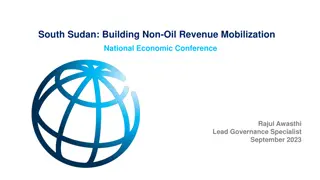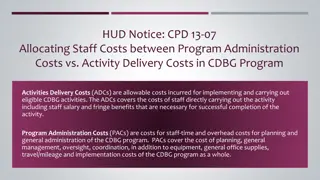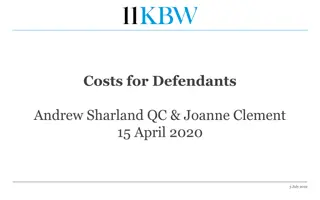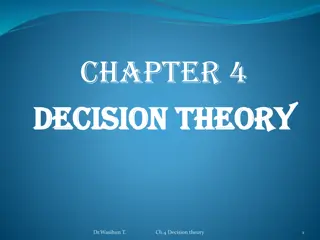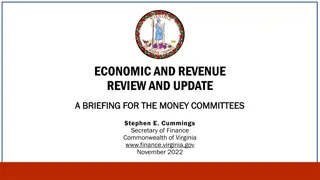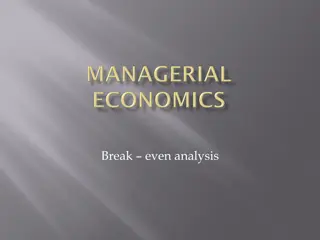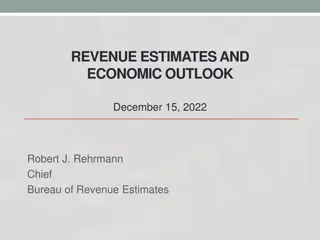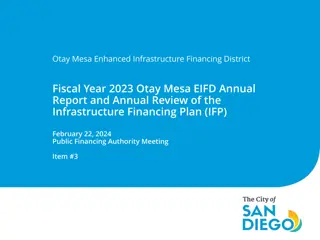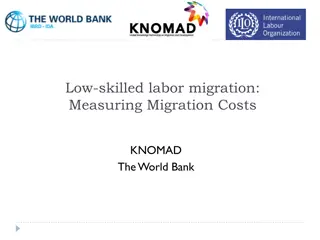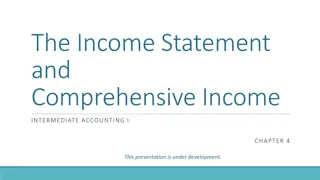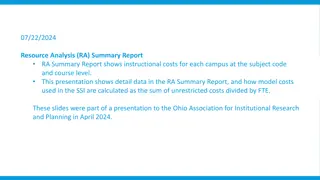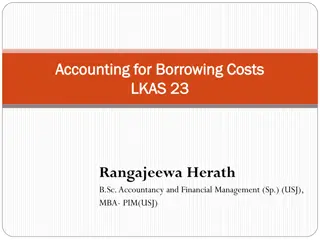Understanding Costs and Revenues for Decision Making
This webinar covers various aspects of cost analysis and revenue calculation essential for decision-making, such as contribution margin, break-even analysis, target profit, contribution to sales ratio, margin of safety, and using break-even analysis in decision-making. Through examples like calculating contribution per unit and total contribution, participants will gain insights into financial analysis techniques for short-term decision-making.
Download Presentation

Please find below an Image/Link to download the presentation.
The content on the website is provided AS IS for your information and personal use only. It may not be sold, licensed, or shared on other websites without obtaining consent from the author. Download presentation by click this link. If you encounter any issues during the download, it is possible that the publisher has removed the file from their server.
E N D
Presentation Transcript
Costs and Revenues The webinar will cover: Calculating contribution Calculating break-even in units and sales revenue Break-even and target profit Calculating and using the contribution to sales ratio Margin of safety and margin of safety percentage Making decisions using break-even analysis.
Calculating contribution Contribution is a key element of short-term decision making Selling price Variable costs = Contribution Contribution per unit is required for break-even calculations.
Example - Calculating contribution Product DTX has a selling price of 38.40 per unit. Each unit requires 1.25 kg of material at 7.20 per kg and 1.4 hours at 12 per hour. Fixed costs are 100,800. Contribution per unit is: 38.40 Selling price Less: Material (1.25 kg x 7.20) 9.00 Labour (1.4 hrs x 12) 16.80 Contribution per unit 12.60
Example - Calculating contribution Product DTX has a selling price of 38.40 per unit. Each unit requires 1.25 kg of material at 7.20 per kg and 1.4 hours at 12 per hour. Fixed costs are 100,800. Contribution per unit is: 38.40 Selling price Less: Material (1.25 kg x 7.20) 9.00 Labour (1.4 hrs x 12) 16.80 Contribution per unit 12.60
Example - Calculating contribution Product DTX has a selling price of 38.40 per unit. Each unit requires 1.25 kg of material at 7.20 per kg and 1.4 hours at 12 per hour. Fixed costs are 100,800. Contribution per unit is: 38.40 Selling price Less: Material (1.25 kg x 7.20) 9.00 Labour (1.4 hrs x 12) 16.80 Contribution per unit 12.60
Example - Calculating contribution Product DTX has a selling price of 38.40 per unit. Each unit requires 1.25 kg of material at 7.20 per kg and 1.4 hours at 12 per hour. Fixed costs are 100,800. Contribution per unit is: 38.40 Selling price Less: Material (1.25 kg x 7.20) 9.00 Labour (1.4 hrs x 12) 16.80 Contribution per unit 12.60
Total contribution Selling price ( 38.40 x 10,000 units) 384,000 Less: Material ( 9 x 10,000 units) Labour ( 16.80 x 10,000 units) 90,000 168,000 Total contribution 126,000 Or: 12.60 x 10,000 units = 126,000 Total contribution Less: Fixed costs Total profit 126,000 100,800 25,200
Example High low method Semi-variable production costs have been calculated as 64,800 at an activity level of 150,000 units and 59,300 at an activity level of 128,000 units. Units 150,000 High 64,800 Low 59,300 128,000 Difference 5,500 22,000 Fixed element: Variable element: 64,800 (150,000 x 0.25) = 27,300 5,500 22,000 units = 0.25 per unit
Student Example 1 A company has identified that the cost of labour is semi-variable. When 12,000 units are manufactured the labour cost is 94,000 and when 18,000 units are manufactured the labour cost is 121,000. Calculate the variable and fixed cost of labour. Units 18,000 High 121,000 Low 94,000 12,000 Difference 27,000 6,000
Student Example 1 - Answer A company has identified that the cost of labour is semi-variable. When 12,000 units are manufactured the labour cost is 94,000 and when 18,000 units are manufactured the labour cost is 121,000. Calculate the variable and fixed cost of labour. Units 18,000 High 121,000 Low 94,000 12,000 Difference 27,000 6,000 Variable element: Fixed element: 121,000 (18,000 x 4.50) = 40,000 27,000 6,000 units = 4.50 per unit
Identifying cost behaviour When the cost divided by the units gives the same answer at both activity levels then the cost is variable When the cost is identical at both activity levels then the cost is fixed When the cost divided by the units gives a different figure at each activity level then the cost is semi-variable.
Poll Question 1 Calculate the variable cost per unit (to the nearest penny) for the following product: 4,000 units 6,500 units Material 22,400 36,400 Labour 30,200 39,700 Production expenses 26,000 26,000 78,600 102,100 A. 13.15 B. 11.71 C. 9.40 D. 19.65 E. 15.71
Poll Question 1 - Answer Calculate the variable cost per unit (to the nearest penny) for the following product: 4,000 units 6,500 units Material 22,400 36,400 Labour 30,200 39,700 Production expenses 26,000 26,000 78,600 102,100 A. 13.15 B. 11.71 C. 9.40 D. 19.65 E. 15.71
Break-even Sales revenue > Costs = Profit Sales revenue < Costs = Loss Break-even point: Sales revenue = Costs
Calculating break-even The calculation of break-even uses the total fixed costs and the contribution per unit Break-even in units: Fixed costs ( ) = Break-even in units Contribution per unit ( )
Example Break-even in units Product DTX has a selling price of 38.40 per unit and total variable costs of 25.80 per unit. Fixed costs are 100,800. The break-even point in units is: 100,800 ( 38.40 - 25.80) = 8,000 units
Break-even in sales revenue Break-even is: Units x Selling Price per unit Using the previous example where break-even has been calculated as 8,000 units and the selling price is 38.40 per unit. 8,000 units x 38.40 = 307,200
Student Example 2 The following information relates to a single product: 8,125 units Sales Variable costs: Material Labour Expenses Fixed costs: Overheads Profit 422,500 87,750 125,125 30,875 Calculate: (a) Contribution per unit (b) Break-even point in units (c) Break-even point in revenue. 143,000 35,750
Student Example 2 - Answer (a) Contribution per unit Selling price per unit: 422,500 8,125 = 52 Variable cost per unit: ( 87,750 + 125,125 + 30,875) 8,125 = 30 Contribution per unit: 52 - 30 = 22 (b) Break-even point in units 143,000 22 = 6,500 units (c) Break-even point in revenue 6,500 units x 52 = 338,000
Target profit Break-even analysis can be used to identify the number of units that need to be sold for the business to reach their desired or target level of profit Fixed costs ( ) + Target profit ( ) = units to be sold Contribution per unit ( )
Example Calculating target profit in units Product DTX has a selling price of 38.40 per unit and total variable costs of 25.80 per unit. Fixed costs are 100,800. The company requires a target profit of 44,100. The number of units to be sold to achieve the target profit is: 100,800 + 44,100 ( 38.40 - 25.80) = 11,500 units
Example Calculating target profit in units Unit price 38.40 11,500 units 441,600 Sales Variable costs: Material 9.00 103,500 Labour 16.80 193,200 Fixed costs: Overheads 100,800 Profit 44,100 Sales revenue required to achieve the target profit is calculated as 11,500 units x 38.40.
Student Example 3 The following information relates to a single product: Selling price per unit Contribution per unit Fixed overheads Target profit 52.00 22.00 143,000 17,600 Calculate: (a) (b) Sales volume to achieve target profit Sales revenue to achieve target profit
Student Example 3 - Answer (a) Sales volume to achieve target profit 143,000 + 17,600 = 7,300 units 22 (b) Sales revenue to achieve target profit 7,300 units x 52 = 379,600
Contributions to sales ratio The contribution to sales ratio or CS ratio expresses contribution as a proportion of sales It can be calculated using the selling price and contribution per unit or the total sales revenue and total contribution. It is calculated as: Contribution per unit ( ) = CS ratio Selling price per unit ( )
Example Calculating CS Ratio Product DTX has a selling price of 38.40 per unit and contribution of 12.60 per unit 12.60 38.40 = 0.328 The CS ratio is: At a sales volume of 10,000 units product DTX has sales revenue of 384,000 and contribution of 126,000. 126,000 = 0.328 384,000 The CS ratio is:
Using the CS Ratio The sales revenue required break-even is calculated as: Fixed costs ( ) CS ratio = sales revenue to break-even The sales revenue required to achieve target profit is calculated as: Fixed costs ( ) + Target profit ( ) CS ratio = sales revenue to achieve target profit
Example Using the CS ratio Product DTX has a selling price of 38.40 per unit and contribution of 12.60 per unit. Fixed costs are 100,800. The company requires a target profit of 44,100. The CS ratio is 0.328. The sales revenue required break-even is calculated as: 100,800 = 307,317 0.328 The sales revenue required to achieve target profit is calculated as: 100,800 + 44,100 = 441,768 0.328
Poll Question 2 The following information relates to a single product 8,125 units 422,500 Sales Variable costs: Material Labour Expenses Fixed costs: Overheads Profit The CS ratio is: 87,750 125,125 30,875 A. B. C. D. 0.085 0.423 2.364 0.577 143,000 35,750
Poll Question 2 - Answer The following information relates to a single product 8,125 units 422,500 Sales Variable costs: Material Labour Expenses Fixed costs: Overheads Profit The CS ratio is: 87,750 125,125 30,875 A. B. C. D. 0.085 0.423 2.364 0.577 143,000 35,750
Margin of safety (MOS) Margin of safety is the excess of budgeted sales over break-even sales It is calculated as: Budgeted volume Break-even volume = Margin of safety in units Margin of safety can also be expressed in sales revenue: Margin of safety in units x Selling price per unit
Example Margin of safety Product DTX has a selling price of 38.40 per unit and total variable costs of 25.80 per unit. Fixed costs are 100,800. Break-even has been calculated as 8,000 units and the company has budgeted to sell 12,000 units. The margin of safety in units is: 12,000 units 8,000 units = 4,000 units The margin of safety in sales revenue is: 4,000 units x 38.40 = 153,600
Margin of Safety % Margin of safety is often expressed as a percentage. The formula is: Budgeted volume Break-even volume Budgeted volume x 100 = MOS %
Example Margin of Safety % Where budgeted volume is 12,000 units, break-even is 8,000 units and margin of safety is 4,000 units, margin of safety percentage is: 12,000 units 8,000 units 12,000 units x 100 = 33% Margin of safety in units x 100 Budgeted volume = MOS %
Student Example 4 The following information relates to a single product: Selling price per unit Contribution per unit Fixed overheads Budgeted sales 52.00 22.00 143,000 8,125 units Calculate: (a) Margin of safety in units (b) Margin of safety in sales revenue (c) Margin of safety %.
Student Example 4 - Answer (a) Margin of safety in units 8,125 units 6,500 units = 1,625 units (b) Margin of safety in sales revenue 1,625 units x 52 = 84,500 (c) Margin of safety % (1,625 units 8,125 units) x 100 = 20%
Making decisions using contribution and break-even 1. Identifying the sales revenue required for a new project to break- even or to reach a target profit 2. Evaluating the effect of increases in production volume and the impact on fixed costs 3. What-if scenarios 4. Assessing alternative projects or major changes to production processes 5. Assessing the viability of a new business 6. Identifying the expected levels of profit or loss at different activity levels.


